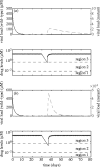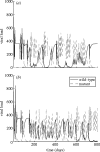Adherence to antiretroviral HIV drugs: how many doses can you miss before resistance emerges?
- PMID: 16537134
- PMCID: PMC1560063
- DOI: 10.1098/rspb.2005.3352
Adherence to antiretroviral HIV drugs: how many doses can you miss before resistance emerges?
Abstract
The question of determining how many doses may be skipped before HIV treatment response is adversely affected by the emergence of drug-resistance is addressed. Impulsive differential equations are used to develop a prescription to minimize the emergence of drug-resistance for protease-sparing regimens. A threshold for the maximal number of missable doses is determined. If the number of missed doses is below this threshold, then resistance levels are negligible and dissipate quickly, assuming perfect adherence subsequently. If the number of missed doses exceeds this threshold, even for 24h, resistance levels are extremely high and will not dissipate for weeks, even assuming perfect adherence subsequently. After this interruption, the minimum number of successive doses that should be taken is determined. Estimates are provided for all protease-sparing drugs approved by the US Food and Drug Administration. Estimates for the basic reproductive ratios for the wild-type and mutant strains of the virus are also calculated, for a long-term average fractional degree of adherence. There are regions within this fraction of adherence where the outcome is not predictable and may depend on a patient's entire history of drug-taking.
Figures




Similar articles
-
Study of the impact of HIV genotypic drug resistance testing on therapy efficacy.Verh K Acad Geneeskd Belg. 2001;63(5):447-73. Verh K Acad Geneeskd Belg. 2001. PMID: 11813503 Review.
-
Emergence of HIV-1 drug resistance during antiretroviral treatment.Bull Math Biol. 2007 Aug;69(6):2027-60. doi: 10.1007/s11538-007-9203-3. Epub 2007 Apr 21. Bull Math Biol. 2007. PMID: 17450401
-
Treatment interruptions predict resistance in HIV-positive individuals purchasing fixed-dose combination antiretroviral therapy in Kampala, Uganda.AIDS. 2007 May 11;21(8):965-71. doi: 10.1097/QAD.0b013e32802e6bfa. AIDS. 2007. PMID: 17457090 Clinical Trial.
-
Guidelines for using antiretroviral agents among HIV-infected adults and adolescents.Ann Intern Med. 2002 Sep 3;137(5 Pt 2):381-433. doi: 10.7326/0003-4819-137-5_part_2-200209031-00001. Ann Intern Med. 2002. PMID: 12617573
-
Preventing and managing antiretroviral drug resistance.AIDS Patient Care STDS. 2004 May;18(5):259-73. doi: 10.1089/108729104323076007. AIDS Patient Care STDS. 2004. PMID: 15186710 Review.
Cited by
-
Option B plus antiretroviral therapy adherence and associated factors among HIV positive pregnant women in Southern Ethiopia.BMC Pregnancy Childbirth. 2019 Feb 28;19(1):82. doi: 10.1186/s12884-019-2228-4. BMC Pregnancy Childbirth. 2019. PMID: 30819147 Free PMC article.
-
Modeling antiretroviral drug responses for HIV-1 infected patients using differential equation models.Adv Drug Deliv Rev. 2013 Jun 30;65(7):940-53. doi: 10.1016/j.addr.2013.04.005. Epub 2013 Apr 17. Adv Drug Deliv Rev. 2013. PMID: 23603208 Free PMC article. Review.
-
Why the HIV Reservoir Never Runs Dry: Clonal Expansion and the Characteristics of HIV-Infected Cells Challenge Strategies to Cure and Control HIV Infection.Viruses. 2021 Dec 14;13(12):2512. doi: 10.3390/v13122512. Viruses. 2021. PMID: 34960781 Free PMC article. Review.
-
Adherence to combination prophylaxis for prevention of mother-to-child-transmission of HIV in Tanzania.PLoS One. 2011;6(6):e21020. doi: 10.1371/journal.pone.0021020. Epub 2011 Jun 10. PLoS One. 2011. PMID: 21695214 Free PMC article.
-
Acceptability of and Willingness to Take Digital Pills by Patients, the Public, and Health Care Professionals: Qualitative Content Analysis of a Large Online Survey.J Med Internet Res. 2022 Feb 18;24(2):e25597. doi: 10.2196/25597. J Med Internet Res. 2022. PMID: 35179509 Free PMC article.
References
-
- Altice F.L, Friedland G.H. The era of adherence to HIV therapy. Ann. Intern. Med. 1998;129:503–505. - PubMed
-
- Ananworanich J, et al. Failures of 1 week on, 1 week off antiretroviral therapies in a randomized trial. AIDS. 2003;17:F33–F37. doi:10.1097/00002030-200310170-00001 - DOI - PubMed
-
- Bainov D.D, Simeonov P.S. Ellis Horwood Ltd; Chichester, UK: 1989. Systems with impulsive effect. Stability, theory and applications.
-
- Bainov D.D, Simeonov P.S. Longman Scientific and Technical; Burnt Mill: 1993. Impulsive differential equations: periodic solutions and applications.
-
- Bainov D.D, Simeonov P.S. World Scientific; Singapore: 1995. Impulsive differential equations: asymptotic properties of the solutions.
MeSH terms
Substances
LinkOut - more resources
Full Text Sources
Medical

